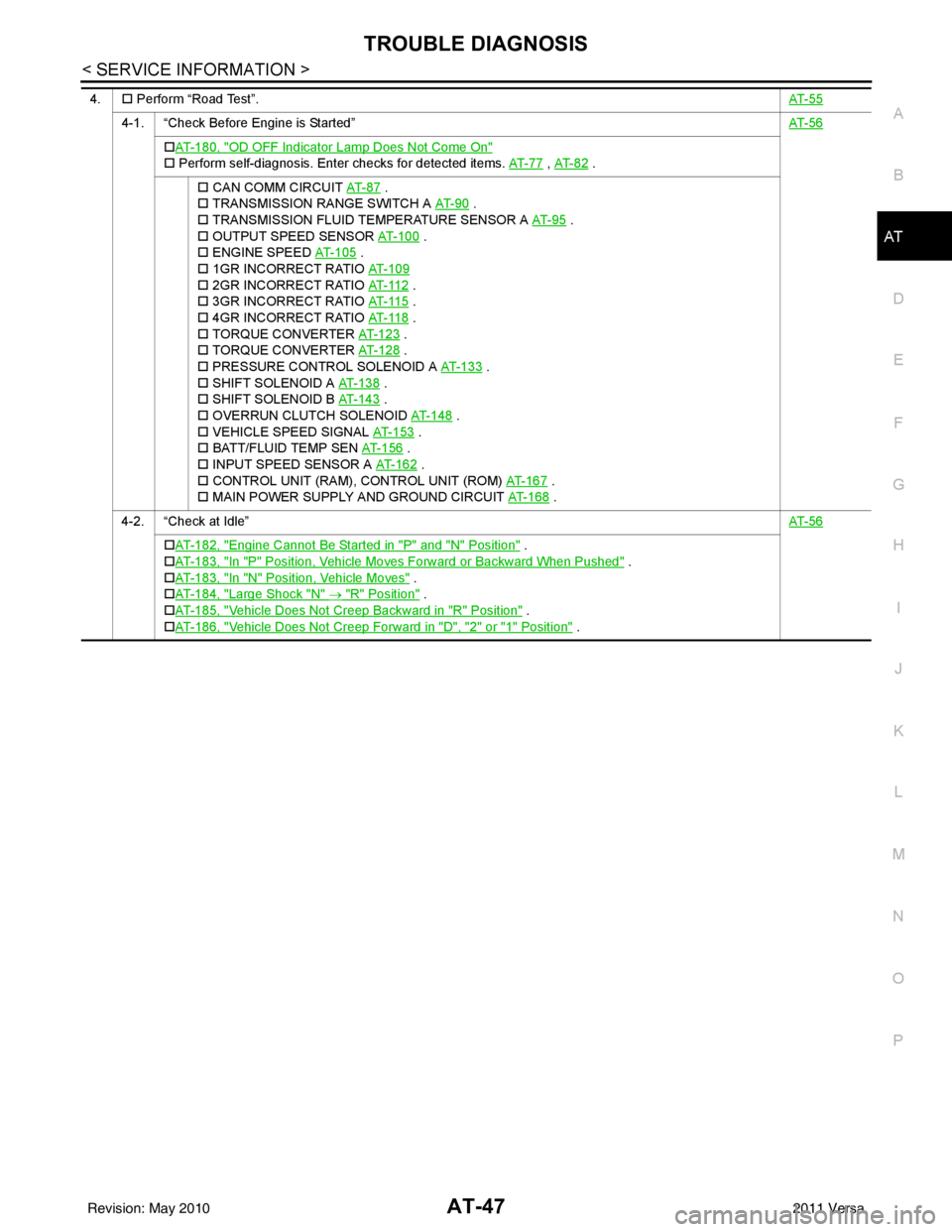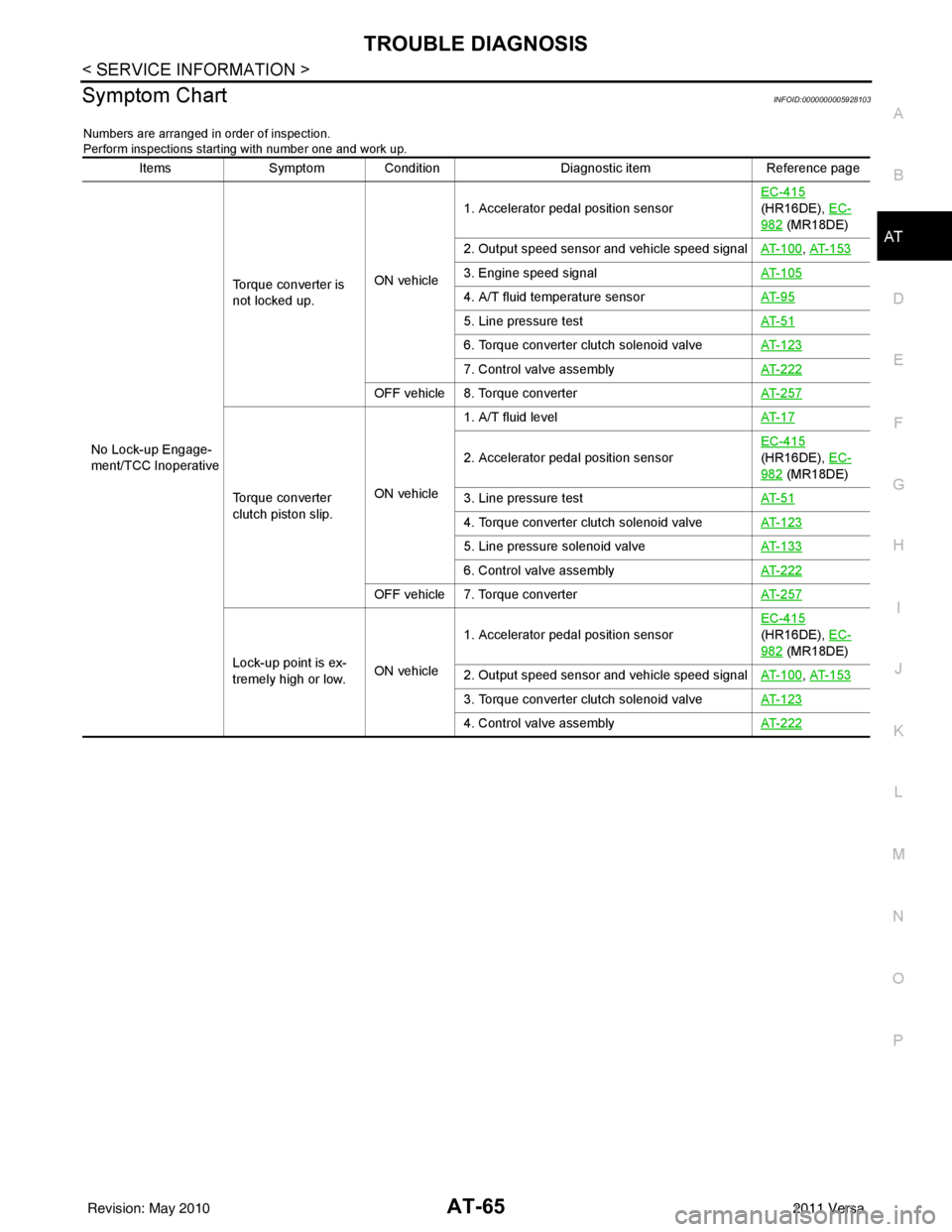2011 NISSAN LATIO sensor
[x] Cancel search: sensorPage 59 of 3787

AT-42
< SERVICE INFORMATION >
TROUBLE DIAGNOSIS
TROUBLE DIAGNOSIS
DTC Inspection Priority ChartINFOID:0000000005928089
If some DTCs are displayed at the same time, perform inspections one by one based on the following priority
chart.
NOTE:
If DTC “CAN COMM CIRCUIT” is displayed with other DTCs, first perform the trouble diagnosis for
DTC “CAN COMM CIRCUIT”. Refer to AT- 8 7
.
Fail-SafeINFOID:0000000005928090
The TCM has an electronic Fail-safe mode. This allows t he vehicle to be driven even if a major electrical input/
output device circuit is damaged.
Under Fail-Safe, the vehicle always runs in 3GR, even wit h a shift lever position of “1”, “2” or “D”. The cus-
tomer may complain of sluggish or poor acceleration.
Always follow the “ AT-43, "
How to Perform Trouble Diagnosis for Quick and Accurate Repair" ”.
The SELF-DIAGNOSIS results will be as follows:
• The first SELF-DIAGNOSIS will indicate damage to the vehicle speed signal or the output speed sensor.
• During the next SELF-DIAGNOSIS, performed after checking the sensor, no damages will be indicated.
FAIL-SAFE FUNCTION
The following fail-safe functions allow vehicles to be driven even when sensor, switch or solenoid malfunction
occurs.
Output Speed Sensor
Vehicle speed signal is input from combination meter.
Accelerator Pedal Position Signal and Throttle Position Signal
TCM controls the throttle opening angle to a predetermined fixed position to enable driving if a malfunctioning
signal is input to TCM.
Transmission Range Switch
When the multiple transmission range switch signals are input to TCM, the priority of selector lever position
becomes “D”, “N”, “R”, “2” and “1” in order by internal TCM determination.
The use of 4GR is inhibited until normal operation resumes. Because the hydraulic circuit of the control valve
is switched by manual valve according to the selector lever position, however, actual operating condition of
vehicle becomes as follows.
Shift Solenoid Valve A and B
If non-standard solenoid signal is sent to TCM, use of certain gears is limited. Refer to chart shown below.
Priority Detected items
1 CAN communication line
2 Except above
Actual lever positionTransmission range switch input signal Running status
“P” “P” position and other position signals P
“R” “R” position and other position signals R
“N” “N” position and other position signals N
“D” “D” position and other position signals D
1 ⇔ D2 ⇔ D3 ⇔ D4
“2” “2” position and other position signals (Except “1” position)
21 ⇔ 22 ⇔ 23
“2” position and “1” position signals 21 ⇔ 22
“1” “1” position and other position signals (Except “2” position)
11 ⇔ 12 ⇔ 13
“1” position and “2” position signals 11 ⇔ 12
Revision: May 2010 2011 Versa
Page 60 of 3787

TROUBLE DIAGNOSISAT-43
< SERVICE INFORMATION >
DE
F
G H
I
J
K L
M A
B
AT
N
O P
�z : Solenoid ON
× : Solenoid OFF
–: Non-standard condition
Line Pressure Solenoid Valve
If non-standard solenoid signal is sent to TCM, line pre ssure solenoid valve is turned OFF to achieve maxi-
mum oil pressure.
Torque Converter Clutch Solenoid Valve
If non-standard solenoid signal is sent to TCM, torque conv erter clutch solenoid valve is turned OFF to release
lock-up.
Overrun Clutch Solenoid Valve
If non-standard solenoid signal is sent to TCM, overr un clutch solenoid valve is turned OFF to engage overrun
clutch. This will result in more effective engine brake during deceleration.
How to Perform Trouble Diagnosis for Quick and Accurate RepairINFOID:0000000005928091
INTRODUCTION
The TCM receives a signal from the vehicle speed sensor, accelera-
tor pedal position sensor or transmission range switch and provides
shift control or lock-up control via A/T solenoid valves.
The TCM also communicates with the ECM by means of a signal
sent from sensing elements used wit h the OBD-related parts of the
A/T system for malfunction-diagnostic purposes. The TCM is capa-
ble of diagnosing malfunctioning parts while the ECM can store mal-
functions in its memory.
Input and output signals must always be correct and stable in the
operation of the A/T system. T he A/T system must be in good oper-
ating condition and be free of valve seizure, solenoid valve malfunc-
tion, etc.
It is much more difficult to diagnose a malfunction that occurs intermittently rather than continuously. Most
intermittent malfunctions are caused by poor electric c onnections or improper wiring. In this case, careful
checking of suspected circuits may hel p prevent the replacement of good parts.
Shift positionNormal
Malfunction in solenoid
valve A Malfunction in solenoid
valve B Malfunction in solenoid
valves A and B
A BGearABGearABGearABGear
“D” position �z�z
1st –�z→×
3rd �z
→× –
3rd ––
3rd
×
�z2nd – �z→× ×–––
×× 3rd – x ×–––
�z ×4th – x �z→× –––
“2” position �z�z
1st –�z→× �z→× –––
× �z2nd – �z→× ×–––
×× 3rd – x ×–––
“1” position �z�z
1st –�z→× �z→× –––
× �z2nd – �z→× ×–––
×× 3rd – x ×–––
SAT631IA
Revision: May 2010 2011 Versa
Page 64 of 3787

TROUBLE DIAGNOSISAT-47
< SERVICE INFORMATION >
DE
F
G H
I
J
K L
M A
B
AT
N
O P
4. �† Perform “Road Test”. AT- 5 5
4-1. “Check Before Engine is Started” AT- 5 6
�†AT- 1 8 0 , "OD OFF Indicator Lamp Does Not Come On"
�† Perform self-diagnosis. Enter checks for detected items. AT- 7 7 , AT- 8 2 .
�† CAN COMM CIRCUIT AT- 8 7
.
�† TRANSMISSION RANGE SWITCH A AT- 9 0
.
�† TRANSMISSION FLUID TEMPERATURE SENSOR A AT- 9 5
.
�† OUTPUT SPEED SENSOR AT- 1 0 0
.
�† ENGINE SPEED AT- 1 0 5
.
�† 1GR INCORRECT RATIO AT- 1 0 9
�† 2GR INCORRECT RATIO AT- 11 2 .
�† 3GR INCORRECT RATIO AT- 11 5
.
�† 4GR INCORRECT RATIO AT- 11 8
.
�† TORQUE CONVERTER AT- 1 2 3
.
�† TORQUE CONVERTER AT- 1 2 8
.
�† PRESSURE CONTROL SOLENOID A AT- 1 3 3
.
�† SHIFT SOLENOID A AT- 1 3 8
.
�† SHIFT SOLENOID B AT- 1 4 3
.
�† OVERRUN CLUTCH SOLENOID AT- 1 4 8
.
�† VEHICLE SPEED SIGNAL AT- 1 5 3
.
�† BATT/FLUID TEMP SEN AT- 1 5 6
.
�† INPUT SPEED SENSOR A AT- 1 6 2
.
�† CONTROL UNIT (RAM), CONTROL UNIT (ROM) AT- 1 6 7
.
�† MAIN POWER SUPPLY AND GROUND CIRCUIT AT- 1 6 8
.
4-2. “Check at Idle” AT- 5 6
�†AT- 1 8 2 , "Engine Cannot Be Started in "P" and "N" Position" .
�† AT- 1 8 3 , "
In "P" Position, Vehicle Moves Forward or Backward When Pushed" .
�† AT- 1 8 3 , "
In "N" Position, Vehicle Moves" .
�† AT- 1 8 4 , "
Large Shock "N" → "R" Position" .
�† AT- 1 8 5 , "
Vehicle Does Not Creep Backward in "R" Position" .
�† AT- 1 8 6 , "
Vehicle Does Not Creep Forward in "D", "2" or "1" Position" .
Revision: May 2010 2011 Versa
Page 65 of 3787

AT-48
< SERVICE INFORMATION >
TROUBLE DIAGNOSIS
4. 4-3. “Cruise Test”AT- 5 8
Part 1
�†AT- 1 8 7 , "
Vehicle Cannot Be Started from D1" .
�† AT- 1 8 9 , "
A/T Does Not Shift: D1→ D2or Does Not Kickdown: D4→ D2" .
�† AT- 1 9 0 , "
A/T Does Not Shift: D2→ D3" .
�† AT- 1 9 2 , "
A/T Does Not Shift: D3→ D4" .
�† AT- 1 9 3 , "
A/T Does Not Perform Lock-up" .
�† AT- 1 9 4 , "
A/T Does Not Hold Lock-up Condition" .
�† AT- 1 9 5 , "
Lock-up Is Not Released" .
�† AT- 1 9 6 , "
Engine Speed Does Not Return to Idle (Light Braking D4→ D3)" .
Part 2 AT- 6 1
�†AT- 1 8 7 , "Vehicle Cannot Be Started from D1" .
�† AT- 1 8 9 , "
A/T Does Not Shift: D1→ D2or Does Not Kickdown: D4→ D2" .
�† AT- 1 9 0 , "
A/T Does Not Shift: D2→ D3" .
�† AT- 1 9 2 , "
A/T Does Not Shift: D3→ D4" .
Part 3 AT- 6 2
�†AT- 1 9 7 , "A/T Does Not Shift: D4→ D3, When OD OFF" .
�† AT- 1 9 8 , "
A/T Does Not Shift: D3→ 22, When Selector Lever "D" → "2" Position" .
�† AT- 1 9 9 , "
A/T Does Not Shift: 22→ 11, When Selector Lever "2" → "1" Position" .
�† AT- 2 0 1 , "
Vehicle Does Not Decelerate by Engine Brake" .
�† Perform self-diagnosis. Enter checks for detected items. AT- 7 7
, AT- 8 2 .
�† CAN COMM CIRCUIT AT- 8 7
.
�† TRANSMISSION RANGE SWITCH A AT- 9 0
.
�† TRANSMISSION FLUID TEMPERATURE SENSOR A AT- 9 5
.
�† OUTPUT SPEED SENSOR AT- 1 0 0
.
�† ENGINE SPEED AT- 1 0 5
.
�† 1GR INCORRECT RATIO AT- 1 0 9
�† 2GR INCORRECT RATIO AT- 11 2 .
�† 3GR INCORRECT RATIO AT- 11 5
.
�† 4GR INCORRECT RATIO AT- 11 8
.
�† TORQUE CONVERTER AT-123
.
�† TORQUE CONVERTER AT-128
.
�† PRESSURE CONTROL SOLENOID A AT- 1 3 3
.
�† SHIFT SOLENOID A AT- 1 3 8
.
�† SHIFT SOLENOID B AT- 1 4 3
.
�† OVERRUN CLUTCH SOLENOID AT- 1 4 8
.
�† VEHICLE SPEED SIGNAL AT- 1 5 3
.
�† BATT/FLUID TEMP SEN AT-156
.
�† INPUT SPEED SENSOR A AT- 1 6 2
.
�† CONTROL UNIT (RAM), CONTROL UNIT (ROM) AT-167
.
�† MAIN POWER SUPPLY AND GROUND CIRCUIT AT- 1 6 8
.
5. �† For self-diagnosis NG items, inspect each component. Repair or replace the damaged parts. AT- 7 7
,
AT- 8 2
6. �† Perform “Road Test”. AT- 5 5
7.�† Perform the Diagnostic Procedures for all remaining items marked NG. Repair or replace the damaged parts.
Refer to the Symptom Chart when you perform the procedures. (The chart also shows some other possible symp-
toms and the component inspection orders.) AT- 6 5
8.
�† Erase DTC from TCM and ECM memories. AT- 3 9,
AT- 8 2
Revision: May 2010 2011 Versa
Page 66 of 3787

TROUBLE DIAGNOSISAT-49
< SERVICE INFORMATION >
DE
F
G H
I
J
K L
M A
B
AT
N
O P
A/T Electrical Parts LocationINFOID:0000000005928092
1. OD OFF indicator lamp 2. Shift position indicator3. Accelerator pedal position (APP)
sensor
4. Input speed sensor 5. Transmission range switch6. Terminal body (Terminal cord as-
sembly connector)
BCIA0037E
Revision: May 2010 2011 Versa
Page 67 of 3787

AT-50
< SERVICE INFORMATION >
TROUBLE DIAGNOSIS
Circuit Diagram
INFOID:0000000005928093
7. Output speed sensor 8. Dropping resistor 9. TCM
10. Overdrive control switch
ABDWA0413GB
Revision: May 2010 2011 Versa
Page 72 of 3787

TROUBLE DIAGNOSISAT-55
< SERVICE INFORMATION >
DE
F
G H
I
J
K L
M A
B
AT
N
O P
Line Pressure
Judgement of Line Pressure Test
Road TestINFOID:0000000005928095
DESCRIPTION
• The purpose of the test is to det
ermine overall performance of A/T
and analyze causes of malfunctions.
• The road test consists of the following three parts:
1. Check before engine is started. Refer to AT- 5 6
.
2. Check at idle. Refer to AT- 5 6
.
3. Cruise test • Inspection all the item from Part 1 to Part 3. Refer to AT- 5 8
,
AT- 6 1
and AT- 6 2 .
Engine speed Line pressure [kPa (kg/cm
2 , psi)]
D, 2nd and 1st positions R position
Idle speed AT- 3 7 4 , "
Line Pressure"Sta ll sp ee d
JudgementSuspected parts
At idle Line pressure is low in all positions. • Oil pump wear
• Control piston damage
• Pressure regulator valve or plug sticking
• Spring for pressure regulator valve damaged
• Fluid pressure leakage between oil strainer and pressure regulator valve
• Clogged strainer
Line pressure is low in particular posi-
tion. • Fluid pressure leakage between manual valve and particular clutch
• For example, line pressure is:
− Low in “R” and “1 ” positions, but
− Normal in “D”, and “2” positions.
Therefore, fluid leakage exists at or around low and reverse brake circuit.
Refer to AT- 2 2 , "
Shift Mechanism".
Line pressure is high. • Accelerator pedal position signal malfunction
• A/T fluid temperature sensor damaged
• Line pressure solenoid valve sticking
• Short circuit of line pressure solenoid valve circuit
• Pressure modifier valve sticking
• Pressure regulator valve or plug sticking
• Open in dropping resistor circuit
At stall
speed Line pressure is low.
• Accelerator pedal position signal malfunction
• Line pressure solenoid valve sticking
• Short circuit of line pressure solenoid valve circuit
• Pressure regulator valve or plug sticking
• Pressure modifier valve sticking
• Pilot valve sticking
SAT786A
Revision: May 2010 2011 Versa
Page 82 of 3787

TROUBLE DIAGNOSISAT-65
< SERVICE INFORMATION >
DE
F
G H
I
J
K L
M A
B
AT
N
O P
Symptom ChartINFOID:0000000005928103
Numbers are arranged in order of inspection.
Perform inspections starting with number one and work up.
Items Symptom Condition Diagnostic itemReference page
No Lock-up Engage-
ment/TCC Inoperative Torque converter is
not locked up.
ON vehicle1. Accelerator pedal position sensor
EC-415
(HR16DE), EC-
982 (MR18DE)
2. Output speed sensor and vehicle speed signal AT- 1 0 0
, AT- 1 5 3
3. Engine speed signalAT- 1 0 5
4. A/T fluid temperature sensorAT- 9 5
5. Line pressure testAT- 5 1
6. Torque converter clutch solenoid valveAT- 1 2 3
7. Control valve assemblyAT- 2 2 2
OFF vehicle 8. Torque converter AT- 2 5 7
Torque converter
clutch piston slip.ON vehicle1. A/T fluid level
AT- 1 7
2. Accelerator pedal position sensorEC-415
(HR16DE), EC-
982 (MR18DE)
3. Line pressure test AT- 5 1
4. Torque converter clutch solenoid valveAT- 1 2 3
5. Line pressure solenoid valveAT- 1 3 3
6. Control valve assemblyAT- 2 2 2
OFF vehicle 7. Torque converter AT- 2 5 7
Lock-up point is ex-
tremely high or low.ON vehicle1. Accelerator pedal position sensor
EC-415
(HR16DE), EC-
982 (MR18DE)
2. Output speed sensor and vehicle speed signal AT- 1 0 0
, AT- 1 5 3
3. Torque converter clutch solenoid valveAT- 1 2 3
4. Control valve assemblyAT- 2 2 2
Revision: May 2010 2011 Versa